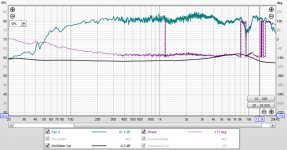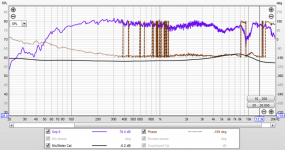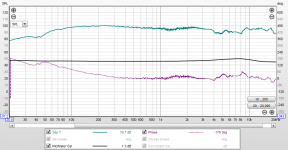Yes, thanks a lot! I went with the Faital Pro 4FE32s and they’re arriving this week.
There seems to be a lot of push for plywood here, but since MDF is probably denser and my climate isn’t particularly challenging, I may go that way and experiment with finishes, maybe a hardwood front panel.
It's about sound & not what's denser. Yes many will argue about this but ???
Many years ago I had a pair of JM Lab MTM point source speakers, 2 version were available MDF or solid Maple, when you do a knuckle test both boxes sounded very innard but once you play music you hear it immediately, Maple box had a livelier sound with more bounce to it. How to expland don't know, you just hear it.
Use a switch to shortcut the filter. Then it is easy to hear the difference.
That is an interesting idea. Thanks! I like it!
How and where do you normally mount your filter? I was thinking beneath the damping material on the back of the cabinet.
While rummaging around in a box recently I uncovered some NOS Tang Band 3" W3-871s drivers that had never found a home. The TABAQ seems like a fun design to try them out as nearfield speakers on my computer desk.
I'm intrigued by TLs but know precious little about which aspects of the design are sensitive to change and which are flexible.
I'd like to end up with the center of the drivers at about 17"/430 mm above the desk. The backs of the speakers will be fairly close to the wall and they'll sit directly on the desk beside my monitor, probably toed in to cross in front of me (if experiments with other speakers hold true here).
1. I've seen folded TABAQ designs with ports out the top and back, but have also read comments that the bass is better with the port on the bottom facing forward. True... or would it not really matter in my setup? It might be easier for the design layout to run it out the back.
2. Assuming the above does matter... I've attached a design variant that shows a forward-facing bottom port, but I can't quite get the height above the desk where I'd like it without making the speaker wider than I'd prefer (currently retains the 100 mm inner width; less would actually be nice). Would lifting the whole speaker the rest of the way via a thicker bottom (= port further from the desk surface) matter for the bass response? Or should I try to angle the port down to the desk?
3. I also raised the driver a little higher (22 mm) than the "axis" of the middle of the TL volume, both to get it closer to ear height and to reduce the forehead above the driver. Would this throw anything off, or otherwise require any adjustments to the dimensions?
4. Is there anything else you'd correct, or suggestions you could make?
Thanks in advance! 🙂
I'm intrigued by TLs but know precious little about which aspects of the design are sensitive to change and which are flexible.
I'd like to end up with the center of the drivers at about 17"/430 mm above the desk. The backs of the speakers will be fairly close to the wall and they'll sit directly on the desk beside my monitor, probably toed in to cross in front of me (if experiments with other speakers hold true here).
1. I've seen folded TABAQ designs with ports out the top and back, but have also read comments that the bass is better with the port on the bottom facing forward. True... or would it not really matter in my setup? It might be easier for the design layout to run it out the back.
2. Assuming the above does matter... I've attached a design variant that shows a forward-facing bottom port, but I can't quite get the height above the desk where I'd like it without making the speaker wider than I'd prefer (currently retains the 100 mm inner width; less would actually be nice). Would lifting the whole speaker the rest of the way via a thicker bottom (= port further from the desk surface) matter for the bass response? Or should I try to angle the port down to the desk?
3. I also raised the driver a little higher (22 mm) than the "axis" of the middle of the TL volume, both to get it closer to ear height and to reduce the forehead above the driver. Would this throw anything off, or otherwise require any adjustments to the dimensions?
4. Is there anything else you'd correct, or suggestions you could make?
Thanks in advance! 🙂
Attachments
Myself, I would probably go with the port on top, just because I like it better there. Front facing port would work too.
As for aiming the driver, either could use a base to raise the whole thing, or do it pro style with a foam isolating wedge under them.
As for aiming the driver, either could use a base to raise the whole thing, or do it pro style with a foam isolating wedge under them.
With the vent on top, when placed on a wall, there are more sensitive to placement, allowing a more precise tweak to adjust the bass according to taste by moving closer or farther from the wall.
Hi
I have enclosed the updated layout som you dont have to browse all posts 😀
Have fun
Bjørn
Bjørn , you should put it on post #1, it would be easy to find. 🙂
I was debating pursuing a commercial application for this. However, I don't think that I will be doing it now.
So I'll pass on an idea if somebody else wants to try it. I suspect aircrete might be an ideal material for this speaker. It is low cost, low weight, soundproof, and acoustically null. Aircrete can be sawed and drilled just like wood. It takes a nail or a screw and can be repaired.
I worked with concrete years ago. The vertical port would be the easier mold in my opinion. It probably would require two pours to make all 6 sides out of aircrete. Build a nice mold, procure a foam dispenser, and make some speakers. This is something pretty much anyone could do in their garage.
So I'll pass on an idea if somebody else wants to try it. I suspect aircrete might be an ideal material for this speaker. It is low cost, low weight, soundproof, and acoustically null. Aircrete can be sawed and drilled just like wood. It takes a nail or a screw and can be repaired.
I worked with concrete years ago. The vertical port would be the easier mold in my opinion. It probably would require two pours to make all 6 sides out of aircrete. Build a nice mold, procure a foam dispenser, and make some speakers. This is something pretty much anyone could do in their garage.
Hi
Any commercial version of TABAQ has to be agreed upon with me 🙂
Kvart&Bølge, the commercial pilot project based on TABAQ - now on hold - we used aluminum cabinet with a foot of casted iron holding the bended port.
Hi
Bjørn
Any commercial version of TABAQ has to be agreed upon with me 🙂
Kvart&Bølge, the commercial pilot project based on TABAQ - now on hold - we used aluminum cabinet with a foot of casted iron holding the bended port.
Hi
Bjørn
Interesting idea and I wonder why I have not seen aircrete enclosures on the forum yet? Maybe xrk971 would be interested if he sees this.I was debating pursuing a commercial application for this. However, I don't think that I will be doing it now.
So I'll pass on an idea if somebody else wants to try it. I suspect aircrete might be an ideal material for this speaker. It is low cost, low weight, soundproof, and acoustically null. Aircrete can be sawed and drilled just like wood. It takes a nail or a screw and can be repaired.
I worked with concrete years ago. The vertical port would be the easier mold in my opinion. It probably would require two pours to make all 6 sides out of aircrete. Build a nice mold, procure a foam dispenser, and make some speakers. This is something pretty much anyone could do in their garage.
My own personal experience is that one can make the most wonderful and beautiful stuff in your garage, but if you cannot get the marketing right it will never be commercially viable.
I feel sorry for you Bjørn, in that Kvart&Bølge is on hold because you have such a fantastic product. Not sure why it's on hold, but certainly the demand for such a product in our part of the woods is pretty low, with a new generation that is largely uneducated in good music and only interested boom boxes and dr dre headphones.
People do not listen to Stereo anymore 🙂
The main problem with K&B was distribution. We would need a partner with more ressourcers. Many of our loudspeakers where ruined by custom that checked what was inside. Furthermore the shipping cost was too high.
/Bjørn
PS: In the 80ties it was very popular to build loudspeakers using cocrete here in Denmark
The main problem with K&B was distribution. We would need a partner with more ressourcers. Many of our loudspeakers where ruined by custom that checked what was inside. Furthermore the shipping cost was too high.
/Bjørn
PS: In the 80ties it was very popular to build loudspeakers using cocrete here in Denmark
There have been a bunch of companies that used concrete/cement for speakers recently. Though these tended to be special versions of concrete. Why nobody has tried aircrete or even talked about it is a mystery. Aircrete would allow larger speakers to be built rather than focusing on bookshelf models. Though aircrete might require thicker walls?
Yes, I know commercial applications of TABAQ require your approval Bjorn. If I was going to try this, I would have. Now I am just passing along an idea for others if they want to try it. Creating aluminum enclosures and wrapping them is not accessible for most diyers. This is. In fact, that "anyone" accessibility could actually solve the shipping conundrum. You could have diyers manufacturing across multiple major cities to eliminate shipping.
Maybe it turns out to be ideal? Just a thought.
On second thought, the vertical port design isn't the only feasible option for concrete, though the Sound Sommelier design would be tough for a diyer.
Yes, I know commercial applications of TABAQ require your approval Bjorn. If I was going to try this, I would have. Now I am just passing along an idea for others if they want to try it. Creating aluminum enclosures and wrapping them is not accessible for most diyers. This is. In fact, that "anyone" accessibility could actually solve the shipping conundrum. You could have diyers manufacturing across multiple major cities to eliminate shipping.
Maybe it turns out to be ideal? Just a thought.
On second thought, the vertical port design isn't the only feasible option for concrete, though the Sound Sommelier design would be tough for a diyer.
Hi guys, I just received my mic, so today I tried to perform a measurement for the first time.
I attached the measurement of my TABAQ Large with the W5-2143 (mic at 10 cm from the speaker), without and with BSC (1mh + 8ohm).
Can somebody help me understand what are those phase spikes? If you have any suggestion regarding the measurement please let me know
I attached the measurement of my TABAQ Large with the W5-2143 (mic at 10 cm from the speaker), without and with BSC (1mh + 8ohm).
Can somebody help me understand what are those phase spikes? If you have any suggestion regarding the measurement please let me know

Attachments
Measurements
Hi Cyrus,
First of all, 10 cm is not a good distance. If you want a near field data, use like 1 cm, then also measure the port at 1 cm, then sum them together. Don’t believe the near field curve above 200 - 300 Hz. If you want the far field data, standard distance is 1 meter. Don’t believe that one below 200 -300 Hz.
The phase curve you have got is very close to -180 degrees angle. Every time it hits the -180, it jumps to + 180. That looks like spikes, which are not real. Once you move the mic to 1 meter, it may go away. However, it may not. A lot of mics invert phase, and looks like yours does too. Try to invert the polarity at the speaker connection to the amp, and see if that brings the phase angle close to zero.
Good luck!
Vadim B.
Hi Cyrus,
First of all, 10 cm is not a good distance. If you want a near field data, use like 1 cm, then also measure the port at 1 cm, then sum them together. Don’t believe the near field curve above 200 - 300 Hz. If you want the far field data, standard distance is 1 meter. Don’t believe that one below 200 -300 Hz.
The phase curve you have got is very close to -180 degrees angle. Every time it hits the -180, it jumps to + 180. That looks like spikes, which are not real. Once you move the mic to 1 meter, it may go away. However, it may not. A lot of mics invert phase, and looks like yours does too. Try to invert the polarity at the speaker connection to the amp, and see if that brings the phase angle close to zero.
Good luck!
Vadim B.
If the measurements are for your own listening pleasure, put the mic at your listening spot, at your ears level.
That will tell you the response you are hearing normally.
If you want to play with EQ, that's the measurement you should use, as it involves all the factors in your room.
That will tell you the response you are hearing normally.
If you want to play with EQ, that's the measurement you should use, as it involves all the factors in your room.
Hi Cyrus,
First of all, 10 cm is not a good distance. If you want a near field data, use like 1 cm, then also measure the port at 1 cm, then sum them together. Don’t believe the near field curve above 200 - 300 Hz. If you want the far field data, standard distance is 1 meter. Don’t believe that one below 200 -300 Hz.
The phase curve you have got is very close to -180 degrees angle. Every time it hits the -180, it jumps to + 180. That looks like spikes, which are not real. Once you move the mic to 1 meter, it may go away. However, it may not. A lot of mics invert phase, and looks like yours does too. Try to invert the polarity at the speaker connection to the amp, and see if that brings the phase angle close to zero.
Good luck!
Vadim B.
Thanks a lot for the info Vadim.
I performed the measurement as you said. Combined driver+port SPL is attached, the phase was behaving the same.
I inverted the polarity and measured at the speaker again and all those phase changes are gone (as per second screenshot). Does this means that I should connect this speaker with inverted polarity? I noticed that in this case I have a drop of ~2db at 45hz.
perceval said:If the measurements are for your own listening pleasure, put the mic at your listening spot, at your ears level.
That will tell you the response you are hearing normally.
If you want to play with EQ, that's the measurement you should use, as it involves all the factors in your room.
Hi perceval, yes that's what I want to achieve. For now I'm trying to perform some measurement to have some basic understanding of the theory behind all of this.
Attachments
Hi, Cyruz. No, this only means that your microphone is inverting phase, which is quite common. You can re-wire the mic cable to invert the phase, but that could be complicated. Just remember to invert the phase of the speaker, while doing measurements, and you will be fine. Much easier that way.
As far as listening, that's a huge can of worms, I don't wish to touch at this time. Let's just say that my PERSONAL preference is to listen to my speakers in positive phase. Some people could disagree. Some amps invert the phase too. Some records are in inverted phase...
Vadim
As far as listening, that's a huge can of worms, I don't wish to touch at this time. Let's just say that my PERSONAL preference is to listen to my speakers in positive phase. Some people could disagree. Some amps invert the phase too. Some records are in inverted phase...
Vadim
- Home
- Loudspeakers
- Full Range
- TABAQ TL for Tangband



